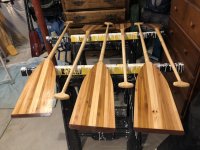The Advantage wasn't intended to be a canoe that requires correction strokes, it was designed to go straight and fast with a bent shaft paddle. The offside yaw that results from hit-and-switch paddling is inherent to the stroke, to keep yaw at a minimum requires good technique. And the Advantage turns but you have to give it some room.When it comes to paddle length, the shorter the paddle I use the quicker my fore arms tire from correction strokes. I would think that a longer paddle will be a benefit in turning a boat with a flat keel because of the added leverage. I also find that I get more power with a longer paddle compared to a shorter one with the same shaped blade. I also think that with a shorter paddle I need to keep up a faster cadence to maintain speed and I don't always want to paddle with a fast cadence.
I find that maintaining the same speed at a slower cadence using a longer paddle and a longer stroke isn't as efficient; I end up having to either add correction (J-stroke) and/or switch sides after fewer strokes. My preference is to maintain a higher cadence with more strokes per side. Or, I just slow down.

